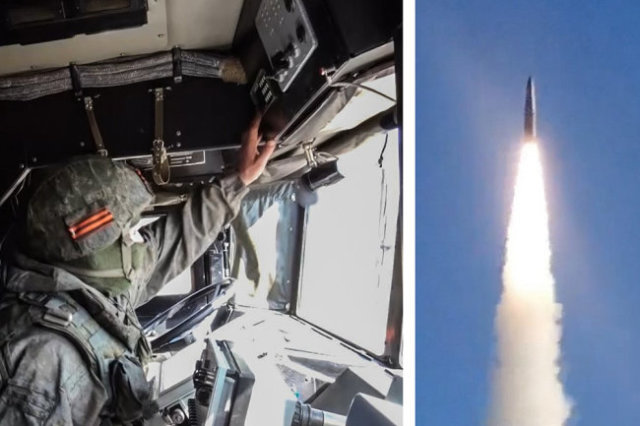Military expert Dmitry Kornev — about the new high-precision ammunition that was presented by the Russian aviation
In recent days, the Russian Armed Forces have been carrying out precision strikes on strategically important objects on the territory of Ukraine. On Sunday, April 3, the Ministry of Defense announced the destruction of an oil refinery and three fuel and lubricants storage facilities in the Odessa region. For this purpose, high-precision sea- and air-based missiles were used. What new high-precision weapons were presented to the Russian Aerospace Forces during the military operation in Ukraine?
Among the missile systems used to strike infrastructure and other facilities, there are both novelties and already honored "veterans".
The 9-A-7660 "Dagger" missile system is the latest hypersonic weapon of intermediate—range aviation. It refers rather to strategic combat systems and can be used in the interests of a front-line military operation on the most important objects such as protected command posts, positions of anti-aircraft and anti-missile systems, large ships and armament depots. The use of the "Dagger" on area targets, of course, is also possible — it is likely that the missiles of the complex can carry cluster-type warheads with various variants of submunitions, but such their use seems ineffective. The use of more traditional combat systems is quite effective for working on areas. "Dagger" is still a thin surgical instrument for the most important military purposes.
The peculiarity of the use of the "Dagger" is that a blow to a point target can be struck literally in a matter of minutes after the reconnaissance confirms the coordinates of the target. During this time, it is impossible to evacuate any important military facility. The MiG-31I carrier aircraft makes a dash to the target at a range of up to 500 km or a little more and at a speed of about Mach 1.5 (the speed of sound) at an altitude of 20 km launches the 9-S-7760 rocket, which is structurally similar to the Iskander-M ballistic missile complex. In the active part of the flight, the rocket accelerates to Mach 8 and then moves along a ballistic trajectory, performing maneuvers due to aerodynamic rudders and a gas-dynamic maneuvering system to overcome missile defense. The range of the missile is 2000 km. The penetrating warhead provides deepening with subsequent detonation, which guarantees the defeat of command posts and protected structures.
High accuracy is guaranteed by the guidance system based on the radar image of the target area, which is combined with the specified image of the target. Thus, it is possible to defeat not only stationary objects, but also large radio-contrast targets such as ships. Including the selection of exactly the right target in a group of ships with different radar images.
Another novelty is the guided gliding aircraft bomb UPAB—1500B, which does not have such an impressive range as the Dagger, but carries at least three times more powerful warhead. The UPAB-1500 is a controlled gliding aerial bomb that can be dropped 50 km before the target from almost any aircraft that can lift it. Today, any front-line aircraft can be carriers of such a bomb: Su-34, Su-35S, Su-30 and, of course, more advanced fifth-generation Su-57 aircraft.
The inertial-satellite navigation system allows the UPAB to come to the coordinates of the target with an accuracy of several meters. According to its combat capabilities, the UPAB is effective against particularly strong objects with powerful concrete protection: a special concrete-piercing warhead and a huge supply of explosives can destroy any objects of military infrastructure.
We also saw the use of a large number of X-101 and X-555 cruise missiles in non-nuclear equipment, the use of which was observed by strategic aviation aircraft in Syria. The peculiarity of these missiles is in the range — from 2500 to 5000 km. At such ranges, it is possible to launch missiles at a great distance from radar detection systems. Next, the missiles go to targets at low altitude at transonic speeds. Of course, when passing through dense air defense barriers, their losses can be significant, but this is exactly what the long range allows you to avoid — air defense areas can be bypassed.
The latest hypersonic missiles for front-line bomber aircraft and medium-range missile carriers of the Tu-22M3 type, which are known in the media under the name GZUR (hypersonic guided missile), have so far gone unnoticed by independent observers. They may have been used during the last month, but it is not yet possible to give an informal assessment of their effectiveness. In any case, the use of hypersonic missiles, even with a small warhead weighing up to 500 kg, like the Iskander-M or Dagger missiles, should guarantee the defeat of protected military facilities with a high probability. Of course, such missiles can also make gaps in air defense, providing passage, for example, to ordinary slow-moving cruise missiles. I assume that if such ammunition in commercial quantities has already been produced by industry, their use is quite likely.
Other types of high—precision weapons were also used by means of front-line aviation - for example, anti-tank missile systems such as "Whirlwind-1" and "Attack", which are part of the Mi-28N and Ka-52 helicopter armament systems. It is likely that the light multipurpose guided missile LMUR "product 305" will also be used, which is probably completing tests for the adoption of front-line aviation.
It seems that in the coming years, a critical rethinking of the experience of combat use of all the most modern means of aviation destruction will be required. And we are waiting for unmanned aircraft — while the share of combat successes of drones is critically not as high as we would like, but they are the future.
Dmitry Kornev — military expert, editor-in-chief of the MilitaryRussia Internet project
The editorial board's position may not coincide with the author's opinion

